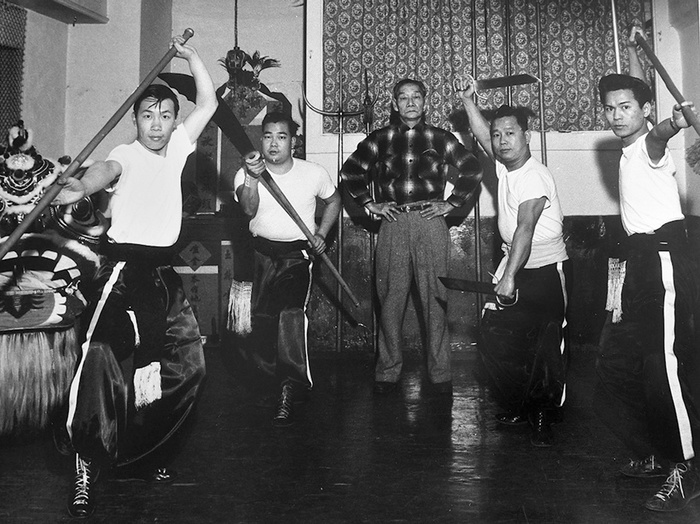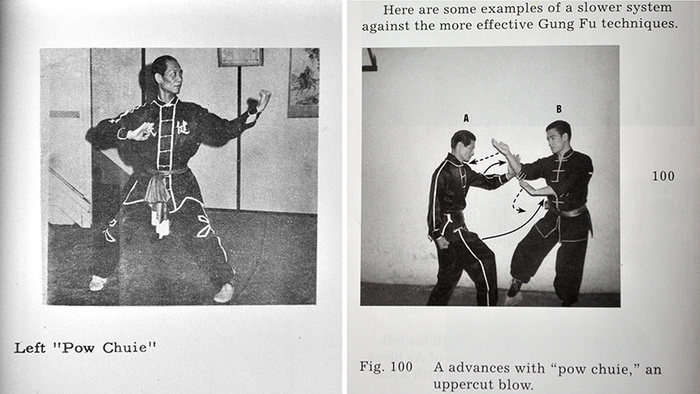Bruce Lee vs. Wong Jack Man: Fact, Fiction and the Birth of(2)
时间:2019-02-26 23:15 来源:互联网 作者:阿刁 点击:次
Lau Bun (left) and TY Wong governed the martial arts culture within San Francisco's Chinatown for three decades. Most descriptions of the Bruce Lee/Wong Jack Man fight have little context for Chinatown's martial arts culture and how it factored into the affair. (Photo Courtesy of UC Berkeley) Chinatown Across the water from Oakland within the city of his birth, Bruce Lee was perpetually at odds with the martial arts culture of Chinatown. In fact, there is a laundry list of little-known incidents and tensions that occurred between Bruce and Chinatown martial artists dating back to when he first returned to America in the spring of 1959. As Bruce quickly learned, San Francisco’s martial arts culture operated in very different fashion from the one he experienced in Hong Kong as a teenager. For about three decades, Chinatown’s kung fu culture was presided over by two longtime local tong enforcers—Lau Bun and TY Wong—whose trailblazing careers have mostly fallen into obscurity. In the 1930s, Lau Bun opened Hung Sing, which is likely the first public school of the Chinese martial arts in America. He maintained a rigid discipline over his students and other martial artists within the neighborhood. For years, Lau Bun did not allow Chinatown to devolve into the sort of daily youth violence that Bruce Lee grew up around on the streets (and rooftops) of Hong Kong during the 1950s, where students from rival martial arts schools regularly challenged each other to fights.
Lau Bun (center) with senior students in Hung Sing, his basement training studio off of Portsmouth Square in San Francisco's Chinatown. In 1959, 18-year-old Bruce Lee would have a little known run-in with this crew. (Photo courtesy of UC Berkeley) TY Wong arrived to San Francisco in the early 1940s. As a junior tong member to Lau Bun, it often fell to TY to clean up rowdy and drunken behavior around the neighborhood’s Forbidden City nightclubs. The name of his school—Kin Mon—translated to mean “the Sturdy Citizen’s Club.” And like Lau Bun, TY expected a specific code of conduct. Word of Hong Kong’s challenge culture and the tenacious reputation of its Wing Chun practitioners had preceded Bruce Lee to San Francisco. Bruce had spent his teen years learning Wing Chun kung fu within Ip Man’s school in Hong Kong, where he enthusiastically embraced the simple and streamlined nature of the style. Economical, swift and direct, Wing Chun emphasizes in-fighting along the opponent’s center line, employing short kicks and rapid punches in close proximity. The style had a reputation for being results-oriented, and on the streets postwar Hong Kong, that was a crucial distinction. Not long after arriving to San Francisco in 1959, Bruce Lee had a heated incident with Lau Bun and his senior students in Chinatown. “When Bruce came to Hung Sing, he didn’t know anything about San Francisco,” recounts Sam Louie, one of Lau Bun’s senior students at the time. “There were seven or eight of us in class. He came down to show off some hands, and tried to say to us that Wing Chun was the best. So our sifu threw him out.”
A comparison of technique stills from TY Wong's 1961 book, Chinese Kung Fu Karate, alongside imagery from Bruce Lee's 1963 book, Chinese Gung Fu. TY, Bruce and James Lee would all package insults into their books from this era, aimed between Oakland and San Francisco. Instantly then, Bruce had gotten off to a bad start within Chinatown. These tensions would only build over time as he increasingly became a vocal critic of traditional approaches to the martial arts, which—in his minimalist Wing Chun mindset—he saw as heavy on flair but short on effectiveness. One of the most pointed examples of Bruce’s criticism is hidden in plain sight within Chinese Gung Fu…, where in a photo-by-photo case study, Bruce is seen dismantling specific techniques that are put forth in one of TY Wong’s earlier books. This is featured in a section titled “Difference in Gung Fu Styles,” in which Bruce distinguishes between what he sees as “superior systems” (namely, his own) versus “slower…half-cultivated systems” (that of TY Wong and other “more traditional” masters like Lau Bun). Bruce’s book was readily on sale within Chinatown, and the insults were not lost on locals. So when TY Wong subsequently characterized Bruce Lee as “a dissident with bad manners,” it was a view shared by most martial artists within Chinatown. (责任编辑:admin) |
- 上一篇:Dragon Tattoos
- 下一篇:江青“肆无忌惮”地谈论毛泽东在延安的私生活

